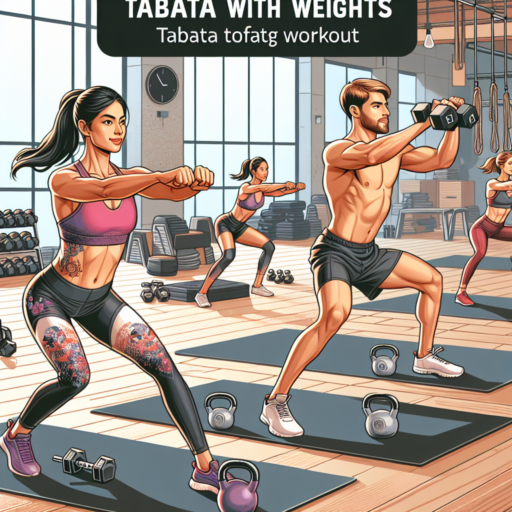Is Tabata with weights effective?
When considering Tabata with weights, it’s crucial to understand the impact of this high-intensity interval training (HIIT) method on strength and cardiorespiratory fitness. Originating from Japan, Tabata’s primary goal was to offer quick but highly effective workouts. By incorporating weights, one might wonder if the effectiveness increases, particularly in muscle building and fat loss.
Benefits of Tabata with Weights
- Improved Muscular Endurance: Adding weights to Tabata workouts challenges the muscles further, enhancing both strength and endurance due to the short rest intervals and high-intensity spurts.
- Increased Metabolic Rate: The combination of weights and Tabata’s fast-paced structure significantly boosts metabolism, leading to more calories burned during and after the workout.
- Better Cardiovascular Health: Despite its focus on weights, this form of Tabata still provides a rigorous cardio workout, improving heart health and stamina.
The question of whether Tabata with weights is effective hinges on one’s fitness goals. For individuals aiming to augment their fitness regimen with a blend of strength and cardiovascular training, this method can offer substantial benefits. The key lies in the execution – using appropriate weights and maintaining the intensity that Tabata demands can dictate the success of such workouts.
Considerations When Doing Tabata with Weights
- Safety: Due to its high intensity, it’s imperative to maintain proper form throughout the workout to prevent injuries.
- Weight Selection: Choosing the right weight is essential; it should be manageable for short bursts but heavy enough to challenge your muscles.
- Experience Level: Those new to fitness or Tabata should start with bodyweight exercises before incorporating weights, to get accustomed to the workout’s pace and demands.
Can you do Tabata for 30 minutes?
Embarking on a Tabata training session for 30 minutes can seem like a daunting feat to many. Traditional Tabata, by its very design, is an intensely compact workout protocol that spans over a period of just 4 minutes. Within these minutes, one undergoes 20 seconds of high-intensity effort followed by a 10-second pause, repeating this cycle for 8 rounds. This high-intensity interval training (HIIT) method pushes your body to its limit quickly, making it an efficient way to boost aerobic and anaerobic capacity.
The thought of extending this vigorous exercise to 30 minutes raises questions about its feasibility and safety. While a full half-hour of continuous traditional Tabata-style intervals might not be recommended due to the extreme physical demand and potential for overtraining or injury, there are ways to incorporate Tabata-inspired intervals into a longer session. By interspersing intervals of Tabata with periods of lower intensity exercise or rest, you can create a dynamic, 30-minute workout that maintains the essence of Tabata’s high-intensity principles without compromising on safety.
Moreover, structuring a 30-minute Tabata session requires careful consideration of one’s fitness level and goals. For beginners, it might be beneficial to start with shorter segments of high-intensity intervals, gradually increasing the duration as endurance and strength improve. Fitness enthusiasts who are well-acquainted with high-intensity workouts may structure their 30-minute session by including a variety of exercises—such as squats, push-ups, burpees, and mountain climbers—cycling through the Tabata protocol. This variation not only helps in targeting different muscle groups but also keeps the session engaging.
How many calories do you burn in 30 minutes of Tabata?
When it comes to burning calories and improving fitness efficiently, Tabata, a form of high-intensity interval training (HIIT), stands out. Understanding the caloric expenditure during a 30-minute Tabata session can be incredibly motivating for those looking to enhance their fitness routine. Typically, individuals can burn between 250 to 400 calories during a half-hour of Tabata, influenced by several factors including weight, intensity, and individual metabolism.
The key mechanism behind Tabata’s effectiveness in burning calories lies in its structure of high-intensity workouts followed by short rest periods. This not only maximizes caloric burn during the workout but also elevates the metabolic rate for hours post-exercise, a phenomenon known as the afterburn effect or excess post-exercise oxygen consumption (EPOC). This means your body continues to burn calories at a higher rate even after the workout has ended.
Diversity in exercises within a Tabata workout also plays a crucial role in its caloric combustion. Incorporating a variety of movements such as sprints, burpees, and squats can help target different muscle groups, further enhancing the overall calorie burn. However, it’s essential to tailor the intensity to your fitness level to prevent injury and ensure sustainable progress. Regularly engaging in Tabata sessions not only aids in burning calories but also improves cardiovascular health and muscular endurance, contributing to a stronger, healthier you.
No se han encontrado productos.
Is 20 minutes of Tabata enough to lose weight?
When considering the effectiveness of 20 minutes of Tabata for weight loss, it’s essential to understand the intensity and mechanics of this workout. Tabata, a form of high-intensity interval training (HIIT), alternates between 20 seconds of ultra-intense exercise and 10 seconds of rest. This cycle is typically repeated for 4 minutes, constituting one «Tabata» set. For a 20-minute session, this cycle would be completed five times. The allure of Tabata lies in its promise to boost metabolism and burn fat at a rate higher than traditional steady-state cardio could offer within the same timeframe.
The calorie-burning potential of Tabata training is noteworthy. Studies suggest that high-intensity interval training can increase your metabolic rate for up to 48 hours after a workout session. This phenomenon, known as the afterburn effect or excess post-exercise oxygen consumption (EPOC), means your body continues to burn calories long after you’ve finished your Tabata workout. However, the actual amount of calories burned during a 20-minute Tabata session can vary based on several factors, including intensity, your body weight, and your muscle mass.
When specifically targeting weight loss, the consistency and dietary aspects accompanying Tabata workouts become crucial. Engaging in 20 minutes of Tabata can significantly contribute to weight loss efforts, especially when combined with a balanced, calorie-controlled diet. The high-intensity nature of Tabata workouts means that they can effectively create a caloric deficit, thereby aiding in weight loss. However, to achieve substantial weight loss goals, incorporating Tabata sessions into a well-rounded fitness regime that includes resistance training and flexibility exercises is advisable for long-term success.




